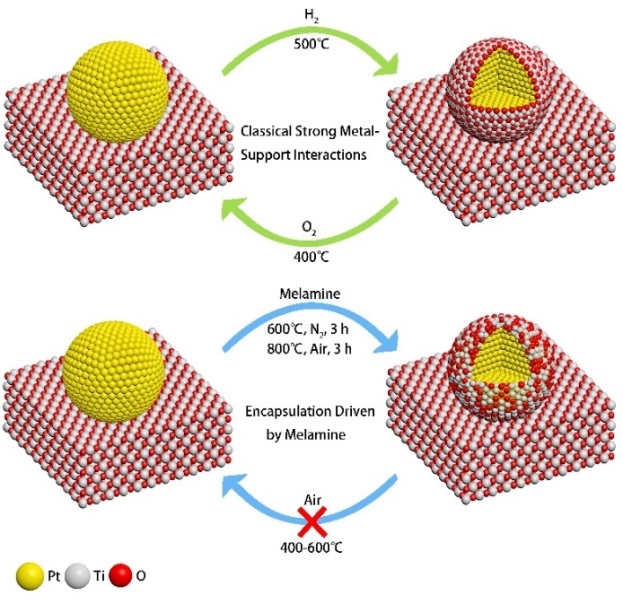Recently, the Center, in collaboration with Prof. Ao Zhimin from the Guangdong University of Technology and Prof. ZHANG Binsen from the Institute of Metals of CAS, constructed a novel type of metal-support strong interaction (SMSI) through the melamine/urea catalyst modification and oxidation atmosphere calcination, developed a new strategy to improve the stability of platinum group metals (PGMs) catalysts. This work was recently published on ACS Catalysis on May 4, 2021.
SMSI is an important concept in heterogeneous catalysis field, which can strongly tune the catalytic performance of catalysts. However, its induced overlayer often covers a number of catalytic active sites, leading to catalysts inactive in a degree. Moreover, the retreat of the overlayer upon reverse atmosphere treatment curtails the effect of SMSI on enhancing the catalytic performance of underlying metals, especially at elevated temperatures. Hence, new synthetic strategies are required to remedy the disadvantages of SMSI. The classical SMSI induced by reduction atmosphere calcination between transition metal oxides and PGMs has been investigated for long time, however, the encapsulation on the same catalysts occurred under oxidation condition has not been tried up to now.
In the previous researches, the collaboration team between Prof. Wang Junhu and Prof. Qiao Botao and Prof. Zhang Tao found the oxygen induced SMSI between gold and PGMs and hydroxyapatite (HAP) (J. Am. Chem. Soc.; Chem. Sci.). Through the modulation of oxygen induced SMSI, a high temperature sintering resistant Au/HAP-TiO2 catalyst with unique semi-encapsulated nanostructure was designed and developed (Angew. Chem. Int. Ed.). Besides, the collaboration team also found the classic SMSI between gold and titanium dioxide (Sci.Adv.).
In 2019, the Center firstly reported that Au nanoparticles can be encapsulated by a permeable TiOx overlayer under oxidative atmosphere (Nat.Commun.). While considering the big difference of electronic property between gold and PGMs, they were not sure whether the latter can exhibit similar encapsulation phenomenon in the similar oxidation condition.

Schematically shown the differences of classical and novel SMSIs separately induced by reduction atmosphere calcination and melamine/urea modification and oxidation atmosphere calcination in the titania-supported platinum catalyst. (Image by Liu Shaofeng)
Here, for the first time, it is reported the evidence that PGMs nanoparticles can be encapsulated by an amorphous and permeable TiOx cover layer on titania-supported catalysts under oxidative atmosphere driven by melamine/urea, contrary to the condition needed for classical SMSI between Ptand TiO2. More importantly, the formed overlayeris stabilized against re-oxidation at 400-600oC in air, in sharp contrast to the retreat of TiOx overlayer by subsequent oxidation treatment in classical SMSI. And further studies proves that the formation mechanism of this kind of encapsulation is different from that of classical SMSI. Such extraordinary strategy is further demonstrated on titania-supported Pd and Rh nanoparticles, paving a promising new way for designing supported PGMs-based catalysts with high activity and stability. (Text by Liu Shaofeng)